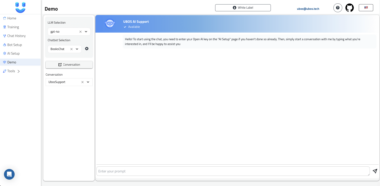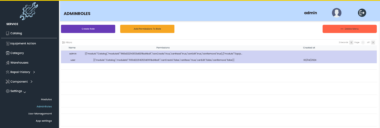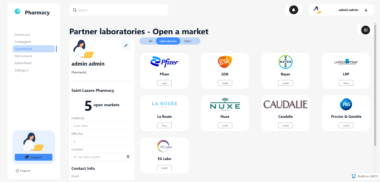Roo Code Memory Bank MCP Server: Empowering AI Agents with Persistent Project Context on UBOS
In the rapidly evolving landscape of AI-driven automation, the ability for AI agents to maintain context across multiple sessions is paramount. The Roo Code Memory Bank MCP (Model Context Protocol) Server, now seamlessly integrated with the UBOS AI Agent Development Platform, provides a robust solution for enabling AI agents to retain and utilize project knowledge, leading to more informed decisions and enhanced overall performance.
What is the Roo Code Memory Bank MCP Server?
At its core, the Roo Code Memory Bank MCP Server acts as a bridge between AI agents and a structured, file-based memory bank. This server, adhering to the Model Context Protocol, allows AI agents to access, store, and update crucial project information, effectively creating a persistent memory for long-running tasks and complex workflows. By leveraging this server, AI agents can avoid starting from scratch each session, significantly improving efficiency and accuracy.
Key Features and Functionalities
The Roo Code Memory Bank MCP Server offers a suite of powerful tools designed to manage and utilize project context effectively:
initialize_memory_bank: This tool facilitates the creation of a structuredmemory-bank/directory, pre-populated with essential.mdfiles. These files, includingproductContext.md,activeContext.md,progress.md,decisionLog.md, andsystemPatterns.md, serve as containers for different aspects of the project’s context. Theinitialize_memory_banktool can also accept an optionalproject_brief_contentstring, allowing for the initial seeding of the project’s background information.check_memory_bank_status: This tool provides a quick and reliable way to verify the existence and integrity of the memory bank. It checks for thememory-bank/directory and lists the.mdfiles contained within, ensuring that the AI agent can readily access the stored project context.read_memory_bank_file: This tool enables the AI agent to retrieve the full content of a specified memory bank file. By providing thefile_name, the agent can access detailed information about the project’s product context, active tasks, progress, decisions, and system patterns. This allows the agent to make informed decisions based on the current state of the project.append_memory_bank_entry: This tool allows the AI agent to add new, timestamped entries to a specified file, optionally under a specific markdown header. This is particularly useful for recording decisions, progress updates, and architectural changes. The tool automatically creates the file if it doesn’t exist, ensuring that the agent can always store new information. This feature ensures continuous learning and adaptation, enabling the AI agent to refine its approach over time.
Use Cases: Unleashing the Power of Contextual AI
The Roo Code Memory Bank MCP Server unlocks a wide range of use cases for AI agents, particularly within the UBOS platform:
- Software Development: Imagine an AI agent assisting with a complex software project. By using the memory bank, the agent can remember the project’s architecture, coding standards, and previous decisions. This allows the agent to provide more relevant suggestions, identify potential conflicts, and ensure consistency across the codebase.
- Content Creation: An AI agent tasked with writing marketing copy can leverage the memory bank to store information about the target audience, brand guidelines, and successful campaigns. This allows the agent to create more engaging and effective content that resonates with the intended audience.
- Customer Support: An AI-powered chatbot can use the memory bank to remember past interactions with customers, their preferences, and any unresolved issues. This allows the chatbot to provide more personalized and efficient support, leading to increased customer satisfaction.
- Data Analysis: An AI agent analyzing large datasets can use the memory bank to store intermediate results, insights, and potential hypotheses. This allows the agent to explore different avenues of research without losing track of its progress.
- Business Process Automation: An AI agent automating business processes can use the memory bank to track the status of each task, identify bottlenecks, and optimize the overall workflow. This can lead to significant improvements in efficiency and productivity.
Seamless Integration with the UBOS Platform
The Roo Code Memory Bank MCP Server seamlessly integrates with the UBOS AI Agent Development Platform, providing a comprehensive solution for building and deploying AI agents with persistent project context. UBOS empowers businesses to orchestrate AI Agents, connect them with enterprise data, build custom AI Agents using their own LLM model and build Multi-Agent Systems.
With UBOS, you can:
- Centralized Agent Management: Easily manage, monitor, and deploy AI agents across your organization from a single platform.
- Data Integration: Securely connect AI agents to your existing data sources, enabling them to access the information they need to make informed decisions.
- Customizable Agent Development: Build custom AI agents tailored to your specific business needs, using your own LLM models and proprietary data.
- Multi-Agent Orchestration: Orchestrate complex workflows involving multiple AI agents, allowing them to collaborate and solve complex problems.
- Enhanced Security and Compliance: Ensure the security and compliance of your AI agents with robust access control and data governance features.
Getting Started with the Roo Code Memory Bank MCP Server on UBOS
Integrating the Roo Code Memory Bank MCP Server into your UBOS workflow is straightforward:
- Clone the Repository: Clone the
roo-code-memory-bank-mcp-serverrepository from GitHub. - Install Dependencies: Install the necessary Node.js dependencies using
npm install. - Build the Project: Compile the TypeScript code into JavaScript using
npm run build. - Configure the MCP Server: Add the server configuration to your UBOS MCP settings file, ensuring to update the path to the compiled
index.jsfile. - Utilize the Tools: Leverage the provided tools (
initialize_memory_bank,check_memory_bank_status,read_memory_bank_file, andappend_memory_bank_entry) within your AI agent’s workflow to manage and utilize project context.
Optimizing AI Agent Performance with Contextual Awareness
By leveraging the Roo Code Memory Bank MCP Server within the UBOS platform, businesses can significantly enhance the performance and capabilities of their AI agents. The persistent project context provided by the server enables agents to make more informed decisions, adapt to changing circumstances, and learn from past experiences. This ultimately leads to more efficient workflows, improved accuracy, and increased overall productivity.
Conclusion: The Future of AI is Contextual
As AI continues to evolve, the ability for AI agents to maintain and utilize context will become increasingly crucial. The Roo Code Memory Bank MCP Server, integrated with the UBOS AI Agent Development Platform, provides a powerful solution for enabling AI agents to retain and leverage project knowledge. By embracing this technology, businesses can unlock the full potential of AI and drive significant improvements in their operations.
Unlock the power of contextual AI. Integrate the Roo Code Memory Bank MCP Server with UBOS today and transform the way your AI agents operate.
Roo Code Memory Bank MCP Server
Project Details
- IncomeStreamSurfer/roo-code-memory-bank-mcp-server
- Apache License 2.0
- Last Updated: 5/1/2025
Recomended MCP Servers


this is a youtube transcriptor
Model Context Server Protocol for your HANA DB
This MCP server provides image generation capabilities using the Replicate Flux model.

An MCP server that enables searches within Obsidian vaults using the Omnisearch plugin API. Returns absolute paths to...
这是一个基于 [ALAPI](https://www.alapi.cn) 的 MCP (Model Control Protocol) 服务器实现,可以通过MCP协议直接调用ALAPI的接口
MCP server for interacting with the Prefect API
esa の Model Context Protocol サーバー実装
Plug FamilySearch into Claude and Cursor AI


Nonfunctioning ClickFunnels MCP for debug
 From vibe coding to vibe deployment. UBOS MCP turns ideas into infra with one message.
From vibe coding to vibe deployment. UBOS MCP turns ideas into infra with one message.






